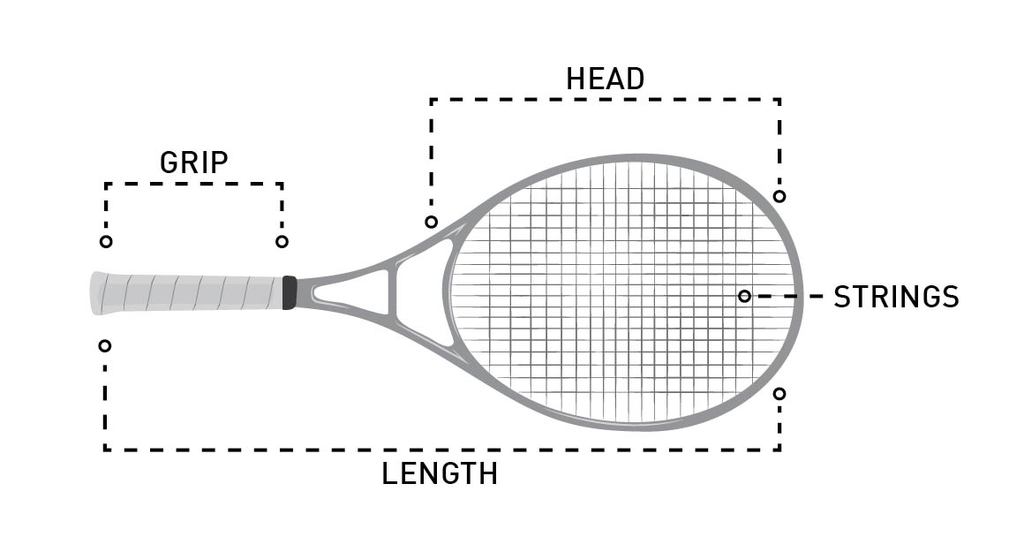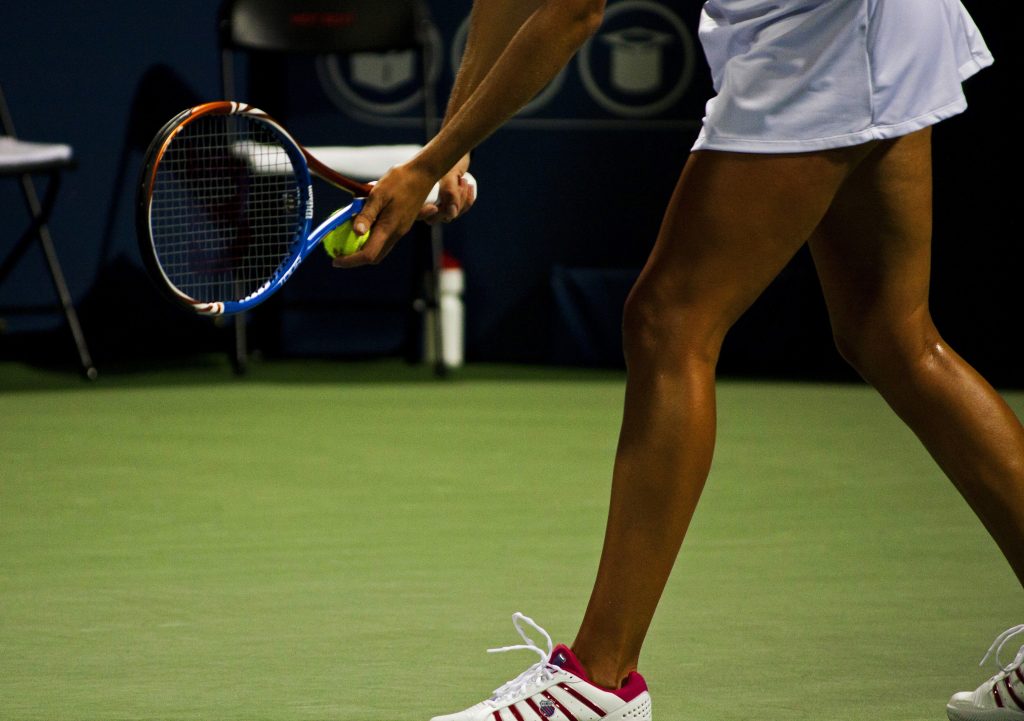HEAD SIZE
For the best tennis racquet, head size is important in a racquet’s performance characteristics. A larger head size often means more power and a larger “sweet spot” (an area in the string bed that suits off-center hits and produces more ball-bounce power from string deformation, known as the trampoline effect. Nevertheless, large head may increase twisting, which cause off-center hits difficult to control and may reduce a player’s power output.
The bigger your racquet’s head, the more ground-breaking your shot. Be that as it may, the shorter the head measure the more control you have. In case you’re in the center, there are average sized types that offer you a tad bit of both.
A smaller head size generally offers more control for many shots, particularly the service and groundstrokes targeted at near the lines, but can lead to more shanks (wild misses, from hitting the frame or missing the sweet spot). This drawback is most common for professional players using single-handed topspin backhands, as well as for recreational and aged players at net.
Midsize
- Range from 100 square creeps to 106 square inches
- Slightly bigger sweet spot
- Better control without surrendering excessively power
- For the more grounded player who gives the majority of the power in a shot

- The head estimate is littler than 100 square inches
- Much better control, yet forfeits power
- Easier for littler players to handle
Oversize
- Measures between 110 square inches and 125 square inches. Super curiously large racquets come as huge as 137 square inches.
- Larger sweet spot implies more power
- More consistency from less mishits
LENGTH
The length of your best tennis racquet is the separation from the base of the handle to the highest point of the head. Length of 21 to 26 inches (53 to 66 cm) is normally the junior racket range, while 27 inches (69 cm) is for stronger more physically-mature players. Some are also available at lengths of 27.5 to 29 inches (70 to 74 cm).
Regular
- The standard 27.5-28 inch racquet is for you in the event that you incline toward a more customary look and feel
- A mix of both power and control
- Easier to deal with in the event that you are a littler player
Long
- More than half of racquets made today are “long racquets”
- Measure between 28.5-29 inches
- Provides more noteworthy use on a swing, and thus, more power
- Easier to cover more region on the court
WEIGHT
The weight of a racquet influences both power and control. With the present progressively lighter racquets, makers have set the vast majority of the weight, or mass, in the make a beeline for increment the power. Shanking due to small racket head size is typically exacerbated by racket weight, which slows the reaction time, as well as, to a lesser degree, the racket’s balance point. The best tennis racquet for you should reduce your error rate.
Heavy
- Generally gauge more than 11 ounces
- Supplies more power
- Helps keep up control
- downside can be lower maneuverability.
Mid-Weight
- Measures between 9.8-10.9
- Offer a mix of control and power
- Very adaptable to fit most sorts of players
Super Light
- Weighs between 9-9.4 ounces
- Superior shot control
- Easier for littler players to handle
STIFFNESS & FLEXIBILITY
When racquet flexes it causes loss of power. All makers have diverse methods for deciding and demonstrating their firmness and adaptability ratings.
- The stiffer the best tennis racquet, the more force is sent to the ball
- Better control of return shots
- Dampens vibration and weight on the elbow
- More control since less force is wasted
HEAD SHAPE
The shape of your best tennis racquet head totally depends on your taste in the ‘looks’ of the racquet and your level of playing skill.
Oval
- The sweet spot dwells in the base portion of this standard-formed head that is favored by traditionalists
- Excellent feel of the racquet
Tear Drop
- The tear drop shape enables a greater amount of the racquet to go about as the sweet spot
- A sweet spot is the territory on the racquet that takes into consideration a strong hit and return. The bigger the racquet, the greater the sweet spot.
- The tear drop-molded racquet permits nearly the whole face to wind up the sweet spot
- New materials have fortified racquet casings to include more consistency
GRIP SIZE
- A appropriately fitted hold will enhance your authority over the tennis racquet, upgrading your performance
- A grasp that is too little will enable the racquet to curve in your grasp and can in the end prompt tennis elbow.
- A grasp that is too substantial will diminish wrist snap on serves and delayed utilize can likewise cause tennis elbow.
STRING TYPE
The stringing pattern affects your play. The way the strings are aligned, in either an open or closed (“dense”) stringing, will affect your power, control, and spin:
- Open stringing offers more spin, which means you can hit the ball harder with top spin.
- Open strings, however, are more likely to break.
- Closed/Dense stringing offers more control for shot placement, and are better for beginners.
Beginners should utilize an essential and adaptable racquet. Curiously large, pre-strung racquets offer the best flexibility and have the biggest sweet spot.
Intermediate players, playing at a club or recreational team level, can attempt lighter, smaller racquets in the event that they are a power player, or bigger racquets if they’re to a greater degree a skillful player.
Advanced tennis players can search for cutting edge composite racquets that offer prevalent power and lightweight feel.
How do you swing?
If you are a power player, meaning you hit the ball with with full force and a long looped swing, a “control racquet.” will be good for you These compact racquets enable you to ‘take the charge’ on the court.
If you consider yourself a skillful player, i.e you have an average swing velocity and shorter strokes, Consider getting power rackets, which will expand the sweet spot and hitting power.
Combination players may show a blend of the above attributes and ought to consider moderate swing tennis racquets.
Finally, How do you String Your Racquet?
Once you have the kind of edge that best accommodates your playing style and swing, you should decide the sort of hanging that suits your game.
Pre-Strung Racquets
- Pre-strung racquets are outfitted towards recreational players
- Versatile for a starting level player
Unstrung Racquets
- These enable you to pick a racquet compose and size and after that tailor the string to your game
- It enables further developed players to modify string and pressure as indicated by your playing style
Natural Gut
- Provides the best, most reliable feel
- Best suited for further developed players due to enhanced execution and feel on shots
- Will should be changed much of the time; not exceptionally durable
Synthetic
- Better suited for recreational players
- Offers a decent parity of sturdiness and playability
- Very little distinction in execution for the normal tennis player
String Gauge
- This is essentially the thickness of the string and the enormous contrast is in toughness and playability
- Thicker strings (15 check) last more, while more slender strings (16 and 17 measure) offer better feel yet are less durable
String Tension
- All tennis racquet outlines accompany maker’s suggestions on string strain and it is best to remain inside those limits
- For more power, the racquet ought to be strung at the low end of the range, since lower strain approaches more power
- Higher string strains offer less power yet accommodate better control
- As a general rule, higher pressures are prescribed for experienced players only
RACQUET CHARTS
| Age |
Racquet |
Ball Type |
| UPTO AGE 5 |
19″ |
Foam |
| 4 to 6 |
21″ |
Foam or Red Felt |
| 7 to 8 |
23″ |
Red Felt |
| 9 to 10 |
25″ |
Orange Felt |
| 10 to 12 |
26″ |
Regular Tennis Ball |
ADULT TENNIS GRIP CHART
RACQUET HAND MEASURMENT
GRIP SIZE: 0 4″1100-103 mml
GRIP SIZE:1 4-1/8″1103-106 mml
GRIP SIZE: 2 4-1/4″l106-110mm)
GRIP SIZE: 3 4-3/8″ 1110-113mm)
GRIP SIZE: 4 4-1/2″1112-118mml
GRIP SIZE: 5 4-5/8″ l116-119mml
In addition to getting the best tennis racket, a great tennis shoes provides comfort and motion flexibility during play, here’s a few reviews we have done.




